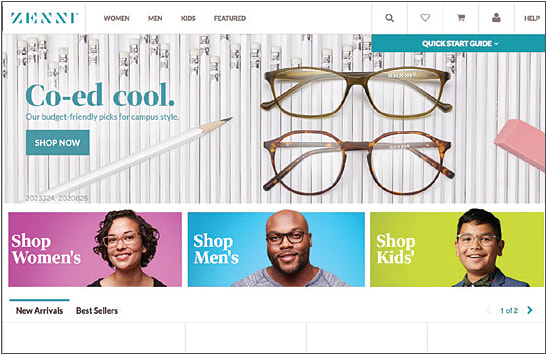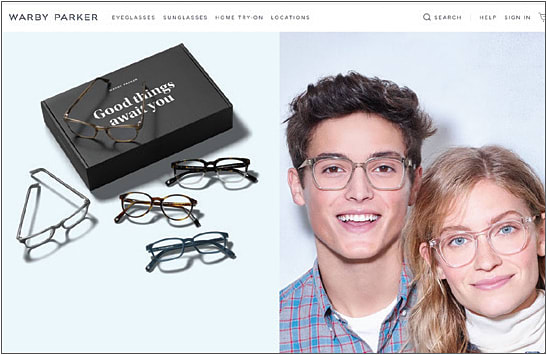
Online sellers of eyewear make a lot of noise. And, they close a lot of deals—4.2% of total prescription eyeglass sales, to be exact, reports The Vision Council. In response, savvy ECPs around the country are upping their competitive game as well.
According to The Vision Council’s Vision Care Market Quarterly Overview for Q1 2018, 3.45 million pairs of ophthalmic frames were sold online during that fiscal quarter. That’s up 8.1% from just a year earlier.
This helps explain why, according to the Eyecare Business Market Trends Study 2017, online eyeglass companies were perceived as the biggest threat among survey respondents. In fact, 45% of respondents pegged online sales as their biggest challenge. That’s up quite a bit—from 30% in 2016.
Here’s a look at both sides of the equation—a status report on three of the biggest online eyeglass retailers, plus some competitive suggestions from several super-savvy brick-and-mortar-based eyecare professionals.
In addition to the three online retailers covered here—Zenni Optical, Warby Parker, and Glasses-USA—the other top-selling websites in the category are EyeBuyDirect.com , Framesdirect.com , Glasses.com , and Coastal.com .
THE BIG, BAD WOLF
So, who’s tops among online purveyors of eyewear? Here’s a look at three of the biggest.
3.45
MILLION
PAIRS OF FRAMES SOLD ONLINE DURING Q1 2018
(UP 8.1% FROM A YEAR EARLIER)
source: The Vision Council
10%
% OF ALL JOBS, ONLINE OR IN-STORE, THAT REQUIRE AFTER-SALE ADJUSTMENTS TO EITHER THE FRAME OR THE PRESCRIPTION ITSELF
source: Forbes

#1 ZENNI OPTICAL
Responsible for about 50% of all online eyewear sales, it is by far and away the biggest kid on the online block.








#2 WARBY PARKER
The first with buy one/give one in online optical, Warby Parker shook things up again when it added bricks to its click.










#3 GLASSESUSA
Known for having a solid service formula, GlassesUSA just celebrated its 10th anniversary.








WHAT’S NEXT?
One challenge is addressing the fact that nearly 10% of all jobs, online or in-store, require after-sale adjustments to either the frame or the prescription itself.
Another is getting consumers comfortable with taking their PDs online, not to mention selecting frames without touching and trying them on. That being said, all of that is much less of a problem with younger consumers than it is with eyeglass wearers over age 40.
The biggest challenge facing online is, of course, putting the whole enchilada—from eye exam to eyeglasses—under one seamless, consumer-friendly online umbrella. Thanks to companies like Opternative, that’s getting closer in terms of technology.
One key question, however, remains: How many of today’s and tomorrow’s eyeglass wearers will buy in?

10 COMPETITIVE TIPS
How are ECPs thriving in today’s wildly competitive landscape? To find out how some eyecare pros suggest competing against the big boys, we spoke with several who have been successful doing just that:
› Colleen Hannegan, management consultant and buyer, Newport Beach, CA
› Chet Steinmetz, O.D., Visual Effects, Chicago
› Ruth Domber, 10/10 Optics, New York City
› Mick Kling, O.D., Invision Optometry in San Diego
1 EXPLAIN
“When patients ask why online is so much cheaper, I sometimes explain the cost of being here…rent, hiring expert staff, maintaining a welcoming store 5 or 6 days a week, plus adjusting, repairing, handling warranty issues. I remind them they can’t buy that online!” —Hannegan
2 TRUST
“If the patient (customer) is already in our ‘store’ for their eye health exam, we have a huge advantage. We have a captive audience that trusts us. It's important to exploit this opportunity. It's ours to lose.” —Kling
3 DIFFERENTIATE
“Practices are in real danger if they haven’t differentiated themselves. But service, problem-solving, and certainly staff demeanor all counteract online.” —Domber
4 PRODUCT
“When you sell the same products as online retailers, the only differentiator in the minds of many shoppers is price. They are looking for a business transaction as opposed to a shopping experience. The answer? Sell something different. Seek out unique and interesting frame lines from independent vendors that will support your business.” —Kling
5 INCENTIVIZE
“Offer even a small incentive to private-pay patients, promote some of your frame inventory at 40% off...special purchases, closeouts, etc. For example, I have a $35 sunglass basket of closeouts, and a small section of our frame stock is at 40% off.” —Hannegan
6 ACCESSIBLE
“Promote and encourage a tactile and interactive experience. Make sure frames are displayed in such a way as to be easily accessible. Providing the ability to touch, feel, and try on the product is one of the most important advantages we have over online retailers.” —Kling
7 AMMO
“Pick your battles. I won’t compete using price, so I have no ammunition if that’s the only factor that drives the sale.” —Steinmetz
8 ADVERTISE
“Consumers are constantly reminded of online. We’ve placed some awesome ads in a couple of local magazines to keep us top of mind, too.” —Hannegan
9 CLEAN
“Clean your house! If your staff is on their phones, if your bathrooms aren’t spotless, and the counters aren’t clean—all that relates to the ability to keep them in-store instead of online.” —Domber
10 HUMOR
“I refer to the online sites as having ‘disposable’ eyewear. Many of my clients who have purchased from them agree. And laugh.” —Steinmetz
The bottom line? People will try online. “Although some leave us, mostly to buy cheap lenses [online], they come back disappointed,” says Hannegan. “That’s when it’s important to welcome them back…and lay on the love.”



